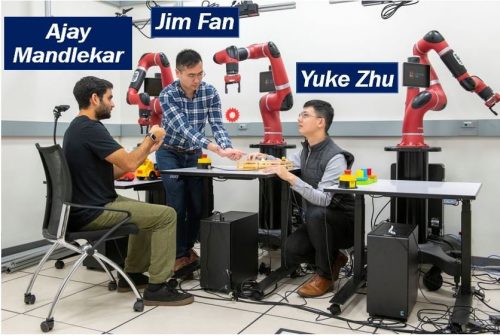At Stanford University, humans are helping robots learn tasks. At Stanford’s Gates Computer Science Building, in the basement, a screen lights up. The screen is attached to a red robotic arm. On the screen, two cartoon eyes blink. Ajay Mandlekar, a PhD student in electrical engineering, says “Meet Bender!”
Bender is one of the robot arms that Stanford engineers are using to test two frameworks – RoboTurk and SURREAL. Together, they will make it easier and faster to teach robots basic tasks.
Helping robots learn with RoboTurk
RoboTurk allows the researchers to direct the robot arm in real time with a cellphone and a browser by showing it how to pick up objects and carry out other basic tasks.
Helping robots learn with SURREAL
SURREAL makes the robot learn faster by running multiple experiences simultaneously. In other words, it allows the robot to learn from many experiences that occur at the same time.
Mandlekar, a member of the research team that developed the frameworks, said:
“With RoboTurk and SURREAL, we can push the boundary of what robots can do by combining lots of data collected by humans and coupling that with large-scale reinforcement learning.”
The team members will be presenting their work and achievements at the Conference on Robot Learning (CoRL) in Zürich, Switzerland (October 29-31).
Team member, Yuke Zhu, A PhD student in computer science, showed how the system works. He opened an app on his smartphone and waved it through the air.
Like a mechanical crane in an arcade game, Zhu guided the robot arm to hover over its prize. The prize was a wooden object the engineers had painted to look like a juicy steak.
This was a simple pick-up-and-place task. It involved identifying the objects and then picking them up. The robot arm then placed them in the bin with the correct label.

Robots learn by interacting and exploring
Picking something up and placing it somewhere, for human beings, is a ridiculously easy task. It doesn’t take long to teach a monkey or even a dog to do that. This is not the case for robots. In fact, they find it quite difficult.
Typically, robots learn by exploring and interacting with their environment. This usually results in lots of random arm waving. They also learn from large datasets.
However, robots learn much faster and more effectively if a human can help them. We can demonstrate to robots how to perform specific tasks in the same way parents do with their kids. When parents teach their children to brush their teeth, for example, they guide their hands.
Those lessons, however, are not perfect. Zhu pressed hard on his iPhone screen and the robot arm let go of the wooden steak. It hit the edge of the bin and ended up on the table.
Mandlekar said:
“Humans are by no means optimal at this, but this experience is still integral for the robots.”
Robots learn faster in parallel
These trials provide invaluable data. Even the failures provide helpful information.
Demonstration data gathered through RoboTurk will give the robots background knowledge to kickstart their learning. To speed the learning process, SURREAL can run thousands of simulated experiences by humans worldwide simultaneously.
Team member, Linxi Fan, a PhD student in computer science, said:
“With SURREAL, we want to accelerate this process of interacting with the environment.
These frameworks help robots learn much faster. They dramatically increase the amount of data from which the robots can learn.
Team member, Animesh Garg, a postdoctoral fellow, said:
“The twin frameworks combined can provide a mechanism for AI-assisted human performance of tasks where we can bring humans away from dangerous environments while still retaining a similar level of task execution proficiency.”
AI stands for Artificial Intelligence. AI refers to software technologies that make robots and computers think like humans. It also makes them behave like humans.
Robots in the future
The researchers envision that robots will become an integral part of our everyday life one day. They will perform repetitive assembly tasks in manufacturing and help with household chores. They will also complete dangerous tasks that may pose a threat to human beings.
Regarding what we should say when giving a robot instructions or orders, Zhu said:
“You shouldn’t have to tell the robot to twist its arm 20 degrees and inch forward 10 centimeters. You want to be able to tell the robot to go to the kitchen and get an apple.”
